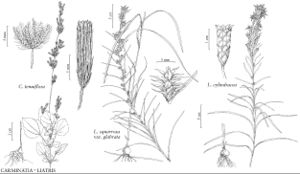Carminatia
in A. P. de Candolle and A. L. P. P. de Candolle, Prodr. 7: 267. 1838.
| Taxon | Illustrator ⠉ | |
|---|---|---|
 | Carminatia tenuiflora Liatris squarrosa var. glabrata Liatris cylindracea | Linny Heagy Linny Heagy Linny Heagy |
Annuals, 10–100+ cm. Stems erect (round to 4-angled or ribbed), unbranched or sparingly branched (from proximal nodes, puberulent and/or villous to pilose, often in lines, sometimes glabrate). Leaves mostly cauline; usually opposite (proximal often withering before flowering, distal sometimes alternate); petiolate; blades (proximal) 3–5-nerved, triangular to broadly ovate (bases obtuse to cordate), margins subentire to dentate, faces glabrous or sparsely villous (at least along veins and on margins), not glanddotted. Heads discoid, in spiciform or narrow, ± paniculiform arrays (subtended by lanceolate to linear, scalelike bracts). Involucres cylindric, [2–] 3–4+ mm diam. Phyllaries persistent (spreading in age), (12–) 17–22+ in 3–4+ series, 3-nerved, lance-deltate or lanceolate to linear, unequal (apices acute to acuminate). Receptacles flat, epaleate. Florets 8–12; corollas greenish white to cream-colored, (bases slightly enlarged, tubes and throats not markedly differentiated externally) throats cylindric to filiform, lobes 5, triangular-ovate (very short); styles: bases not enlarged, glabrous, branches ± filiform (appendages linear or weakly clavate). Cypselae ± prismatic (usually 5-angled) or subcylindric, usually 5-ribbed, minutely puberulent; pappi usually readily falling, of 8–13 plumose bristles or setiform scales in 1 series (basally coherent or weakly connate, falling together or in groups). x = 10.
Distribution
sw United States, Mexico, Central America (Guatemala)
Discussion
Species 3 (1 in the flora).
Selected References
Lower Taxa
"fine" is not a number.